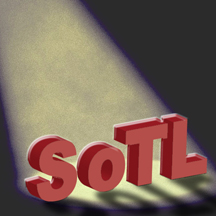SoTL Spotlight: Public Performances of Learning
 by Nancy Chick, CFT Assistant Director
by Nancy Chick, CFT Assistant Director
Nancy is the author of a variety of scholarship of teaching and learning (SoTL) articles and book chapters, as well as co-editor of two books on signature pedagogies and co-editor of Teaching & Learning Inquiry, the official journal of the International Society for the Scholarship of Teaching and Learning (ISSOTL). “SoTL Spotlight” is her ongoing feature on the CFT website.
I’m in Savannah, Georgia, for the SoTL Commons conference. The weather is beautiful, the flowers are blooming, and the tourists are everywhere.

As often happens, the conference has my mind buzzing with ideas and projects. Most notable so far is the conversation I just had over dinner with Peter Felten (Executive Director of Center for the Advancement of Teaching and Learning at Elon University) and Taylor Binnix (a Psychology major at Elon University). Taylor was telling us about her dance minor, and Peter pointed out that students in dance (and the other performing arts) must publicly perform their learning in ways that most other students don’t. “Yes,” Taylor agreed, “I never have to say ‘Come read my psychology research paper’ to anyone but the professor at the end of my other courses.”
In SoTL, we talk about how students “perform” their learning in papers, exams, projects, presentations, labs, discussions, and the like. These are the moments when we see and assess their learning. However, these performances are typically private, shared only with the professor and perhaps the rest of the class. Fears of FERPA and IRBs make many of us overprotective of our students’ work, ensuring that we alone see what are arguably the best moments of university life.
Lee Shulman (educational psychologist and former president of the Carnegie Foundation for the Advancement of Teaching) has written about the private nature of teaching in an article entitled “Putting an End to Pedagogical Solitude”:
“We experience isolation in the classroom. We close the door and experience pedagogical solitude, whereas in our life as scholars, we are members of active communities of conversation and evaluation in which we gather with others…to exchange our findings, our methods, and our excuses.” (Shulman 1993, p. 6)
He argues for us to share our teaching, just as we do our research—to “celebrate those aspects of our lives and work that can become, as we say in California, ‘community property.’” Some embrace this notion through SoTL by presenting or writing about what, how, and why we teach, and what, how, and why students learn (or don’t) as a result.
What about the solitude of learning? Through SoTL, we go public with our teaching and our students’ learning—but these are typically our moments, our conferences, our publications. (True, there is an increasing effort to include students as partners in SoTL [Werner & Otis, 2009], but this is not yet the norm.) How can we and the students “celebrate” their learning and make it “community property”?
It’s not a new question. Randy Bass (Professor of English and Executive Director of the Center for New Designs in Learning and Scholarship at Georgetown University) and Heidi Elmendorf (Associate Professor of biology at Georgetown University) have been talking and writing about “social pedagogies” for a few years.
Social pedagogies are “design approaches for teaching and learning that engage students with what we might call an ‘authentic audience’ (other than the teacher), where the representation of knowledge for an audience is absolutely central to the construction of knowledge in a course.” (Bass & Elmendorf, 2012)
Their white paper outlines the benefits of such public representations, such as recognizing learning as both process and product, developing a sense of voice and a purpose beyond the classroom, getting feedback from a variety of perspectives, participating in a larger community, and cultivating an “integrated sense of personal and intellectual significance.”
CFT Director Derek Bruff applies Bass and Elmendorf’s notion of social pedagogies by encouraging us to consider the many ways social media can provide audiences for students’ public performances. Course blogs, social bookmarking, Twitter back channeling, and collaborative writing on wikis are just a few examples. (Visit “Course Blogs at Vanderbilt,” a “motherblog of live feeds from various Vanderbilt course blogs.”)
But Taylor’s dance performances are regular, expected in every course and integral elements of the discipline. I’m intrigued by this combination of public performances of learning that are a) for a real audience and, more importantly, b) authentic to the discipline.
Peter described an activity from when he taught at Vanderbilt: he brought colleagues with relevant areas of expertise to his class to help students as they were writing their research papers. These guest experts didn’t read the papers; instead, the students in small groups briefly explained their work to the guest, who asked questions and gave formative feedback, which the students could then incorporate into their papers. The learning was still happening, so this activity seems like an appropriately low-stakes performance. (The students are still in the classroom, but the door is open.) Significantly, though, the performance isn’t unlike the work of historians who may share their ideas with trusted colleagues as they are developing them, opening themselves up to early peer review to improve their final products. This happens more formally at conferences but informally between colleagues as well.
In my women’s studies courses, I’ve frequently ended the semester with a poster session in which students share their projects with the campus. Announced campus-wide ahead of time, the session took place in a common area at lunchtime, and the students talked about their work with people from many disciplines. In contrast to Peter’s guest experts visiting class during the intermediate stages of learning, this performance was a final activity with a wide and largely unfamiliar audience (fitting for an interdisciplinary program like women’s studies), positioning the students as relative experts. This activity—on a small scale—reflects the value women’s studies places on taking action by encouraging others’ critical consideration of gender issues and creating change. It also reflects the common scholarly activity of the poster presentation.
What are other discipline-authentic ways in which our students can more publicly share their learning—for formative or summative feedback, and even for celebration? Where is it happening on Vanderbilt’s campus?
References
- Bass, Randy and Heidi Elmendorf. (2012). “Social Pedagogies: A Teagle Foundation White Paper.” Randy Bass.
- Bruff, Derek. (Nov 6, 2011). “A Social Network Can Be a Learning Network.” Chronicle of Higher Education.
- Shulman, Lee. (Nov 1993) “Putting an End to Pedagogical Solitude.” Change 25(6). 6-7.
- Werner, Carmen & Megan T. Otis. (2009). Engaging Student Voices in the Scholarship of Teaching and Learning. Sterling, VA: Stylus.

Leave a Response